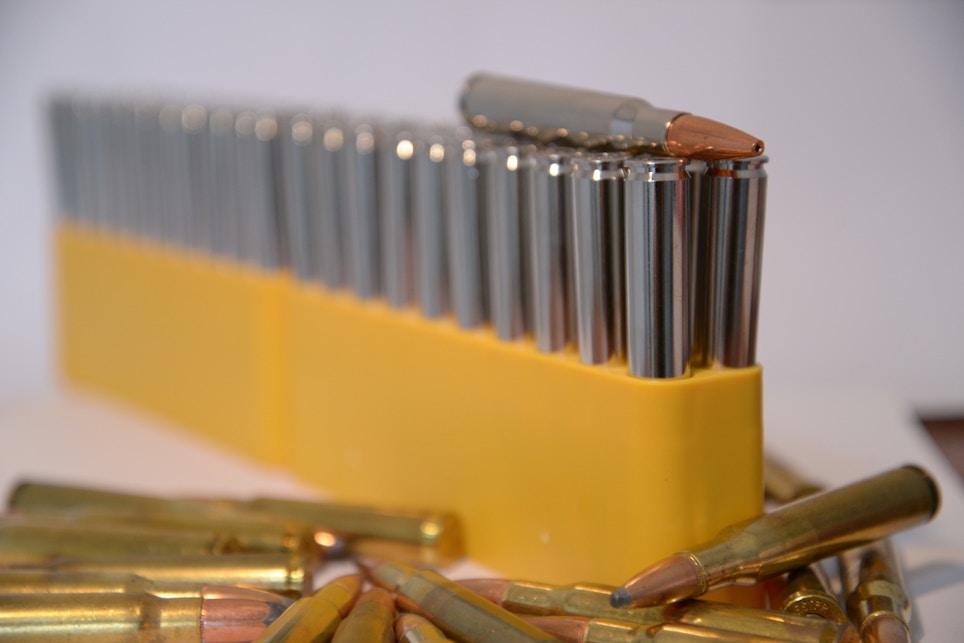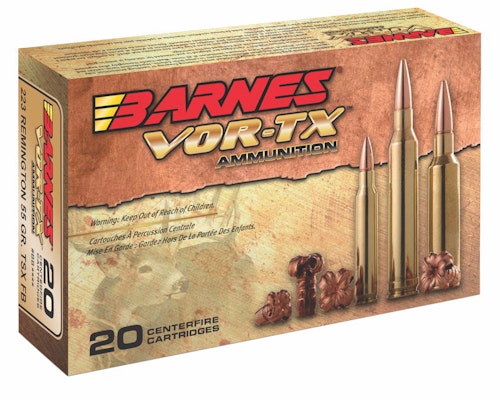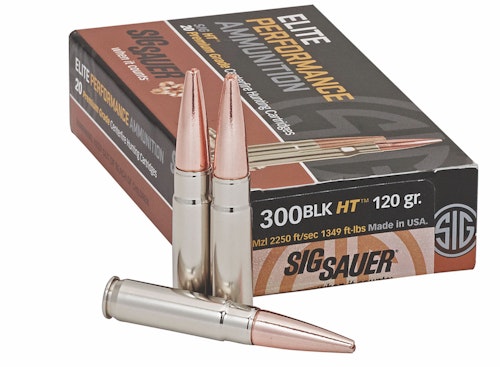Lead ammo works. So why change?
Most major ammunition manufacturers have introduced non-lead options over the past decade or two. Browning, Federal, Winchester, Sig Sauer and Hornady all offer proven non-lead cartridges, and there are plenty of others, big and small. A portion of your customer base no doubt is interested in these lead alternatives, and you need to be able to steer them in the right direction.
Knowledge is one of the most valuable commodities you can offer. You don’t have to be an expert in ballistics, or provide details about the Coriolis effect on a beanfield shot for a whitetail. But being knowledgeable enough to recommend a specific caliber for elk, for example, is a plus. Customers will of course appreciate it if you can also walk them through ammunition options and help them find the right solution for their specific needs.
Material Change
When it comes to selling ammunition, most sales are straightforward. In most cases, and from the first cartridges developed by Winchester in 1873, the projectile has been made of lead. When it hits the target, it will mushroom or break apart as it delivers and disperses the energy that sent it on its path.
That’s pretty much what the average customer knows about ammunition. What they often don’t know, and what you, the retailer, can convey, is that nontoxic ammunition performs as well or better. Nontoxic ammunition is better for other wildlife, and better for the environment. It is better for the hunter, who may not care to dig around trying to find pieces of a bullet that broke apart inside an animal.
When I started hunting deer, everyone shot lead cartridges and that was it, because that’s what you had and used. It worked for the military. It worked for hunters. Non-lead ammo wasn’t even a consideration. Outdoors stores, Western Auto and Otasco, even most rural gas stations, all offered the popular options in .243, .270, .308 and .30-06, usually along with a selection of .22 and 12-gauge. Yellow No. 2 pencils had lead, gasoline had lead and rifle ammunition had lead.
Then, in 1979, Randy Brooks was hunting brown bears in Alaska with his wife Coni when he thought about an all-copper bullet that would expand, penetrate and deliver ample power. His wife — like many hunters then and even now — wondered why he would change anything. The couple had recently taken ownership of Barnes Bullets, and on that Alaska hunt almost 50 years after the company was founded by Fred Barnes, Randy was suggesting something radical. He persisted, and in 1989 introduced the Barnes X-Bullet.
Since then, the industry — including retailers and hunters — has slowly taken more interest in all-copper and other non-lead ammunition. It hasn’t taken over a huge share of the ammo market, but lead and lead-free ammunition share shelf space.
Environmental Perspective
Since 1989, more companies have begun producing non-lead ammunition options for big game hunting. Copper is the preferred medium, as it can be sourced and efficiently produced into consistently precise bullets. Copper takes down game animals large and small, as Brooks proved with the X-Bullet and other companies’ bullets have proven since then. Non-lead ammunition is required for all hunting in California, and other states have varied requirements for nontoxic ammunition (mostly for birds, and on state or refuge lands).
Companies make it. Retailers sell it. Why isn’t lead-free ammunition used more throughout the United States for big game? I talked with Leland Brown, a longtime hunter and the Non-Lead Hunting Education Program director with the Oregon Zoo. Brown works in partnership with the Oregon Department of Fish & Wildlife, Oregon Hunters Association and other stakeholders. He is also involved with Hunting with Non-Lead Ammunition, an organization that seeks to inform and educate the public about lead-free options. I also spoke with Daryl Ratajczak, the former Chief of Wildlife and Forestry for the Tennessee Wildlife Resources Agency.
Both men are longtime hunters. Both have backgrounds in the woods as well as with various stakeholders. They have purchased ammunition in small shops, hunted big and small game, and Brown was part of a culling project while working in Hawaii. Safe to say they’re educated and know what’s going on in the wild with hunters and animals.
“As with most topics in hunting there are a lot of different opinions,” Brown says. “Industry and hunting media continue to recognize non-lead bullets as high performance, as they often appear in the ‘top 10’ lists for best big-game bullets. We see a lot of folks already using them, and the interest does appear to be growing. As hunters learn more about the advantages of non-lead ammo, we keep seeing more interest.”
Ratajczak agrees, noting that despite some interest in lead-free ammunition, most hunters gravitate toward what’s comfortable. He doesn’t see the industry pushing to make any big changes at the moment, either, or hunters demanding more lead-free ammo.
“I think non-lead ammunition industry still has a long way to go. Although I am seeing more and more serious shooters talking about the advantages and better performance in non-lead substitutes, the majority of everyday hunters still have an affinity toward lead,” Ratajczak says. “I’m not as active in hunting forums as I used to be but I still check the pulse on some of the larger ones. Whenever the topic of switching from lead ammunition for big game comes up, the thread usually gets closed down pretty quickly because the angry ‘mob’ comes out. Sadly, the mob has very few logical talking points but they do have safety in numbers. If there has been a move in numbers it is minimal at best. The hunting public is still a very lead-oriented group.”
Learning Curve
As with any change in ammunition, there’s a learning curve involved. Brown discovered it in 2010 while in Hawaii with the culling work he was doing on feral pigs. Waterfowl hunters learned about it decades ago switching from lead to steel, and then when they added bismuth, tungsten and alloys. Part of the evolution of going lead-free for big-game hunting will be education and the learning curve.
“Any change in ammunition requires some adaption to the characteristics of the new bullet, load, etc.,” Brown says. “Ballistic charts change, and learning the drops for the new ammunition makes for a more effective hunter. Non-lead bullets shoot at the same velocities and pressures as any other bullets, so any differences tend to be in line with any other differences between ammo types. They do tend to be slightly longer for the same bullet weights, so you can often drop down in weight to get better accuracy by matching the bullet length to the twist rate, while also getting higher velocities, which means flatter shooting out to medium range.
“Hunters can expect very high weight retention, consistent expansion, and great penetration due to the weight retention,” he adds. “As with any bullet (no matter what material) know the minimum velocity for expansion (generally 1,800-2,000 fps) and make sure to keep shots within range to make sure they work as intended.”
These are the sorts of things your customers will want to know. Being able to provide some basic information will go a long way. Lead-free bullets still mushroom. They still will deliver killing energy. They still will fire from a rifle. It’s just a different material. Brown says his initial thoughts were like many hunters: Why change something that’s worked for years?
“As a wildlife biologist, I wanted to see some evidence that there was a reason,” he said. “After seeing the available research I was surprised by how much information was available. I started using them, and the performance convinced me that I had some really great bullets. The consistency in performance, accuracy and penetration, as well as the field performance on all the animals I have been lucky enough to take showed me the massive benefits of non-lead bullets. Adding the stewardship and conservation benefit was a cherry on top.
“Right now everything is hard to find, (and it) doesn’t much matter what you’re looking for. We were seeing things improve as far as availability prior to 2020. A lot of manufacturers are making options, and more stores are carrying a selection. I would say that stores shouldn’t be afraid of stocking non-lead options. Know how they work and be able to share the potential benefits with customers, and it’s likely they will come back for more.”
Better Options
Lead is found in nature. That’s indisputable. It has been used by humans since 3,000 B.C., despite being toxic. It was documented to have killed people during Roman times, and was used in multiple things from cosmetics to water pipes and money. We have continued to use it in myriad ways. So, what’s the big deal about using lead in ammunition? The bottom line is there are better options that can be beneficial. Hunters and industry personnel preach about conservation, stewardship and how we all should do our part. This is one of the ways.
“Uranium is found in nature so should we say that’s no big deal either?” Ratajczak asks. “Almost every substance we find on earth is found in nature so using a third-grade defense like that doesn’t carry much weight. Truth be told, the non-science debates are what is really hurting our society more than anything. More and more studies are coming out, not only regarding the negative impacts of lead in wildlife, especially birds, but also the amount of lead that they are finding. It’s pretty alarming.
“Listen, I know science isn’t perfect but it was never meant to be,” he adds. “It is meant as a learning tool. We gather more data, we test more things, we learn from our mistakes, and we draw better conclusions. Now is the time we start drawing better conclusions on our use of lead.”









